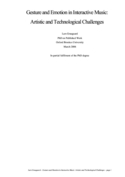“This dissertation presents a new and expanded context for interactive music based on Moore’s model for computer music (Moore 1990) and contextualises its findings using Lesaffre’s taxonomy for musical feature extraction and analysis (Lesaffre et al. 2003). In doing so, the dissertation examines music as an expressive art-form where musically significant data is present not only in the audio signal but also in human gestures and in physiological data. The dissertation shows the model’s foundation in human perception of music as a performed art, and points to the relevance and feasibility of including expression and emotion as a high-level signal processing means for bridging man and machine. The resulting model is multi-level (physical, sensorial, perceptual, formal, expressive) and multi-modal (sound, human gesture, physiological) which makes it applicable to purely musical contexts, as well as intermodal contexts where music is combined with visual and/or physiological data.
The model implies evaluating an interactive music system as a musical instrument design. Several properties are examined during the course of the dissertation and models based on acoustic music instruments have been avoided due to the expanded feature set of interactive music system. A narrowing down of the properties is attempted in the dissertation’s conclusion together with a preliminary model circumscription. In particular it is pointed out that high-level features of real-time analysis, data storage and processing, and synthesis makes the system a musical instrument, and that the capability of real-time data storage and processing distinguishes the digital system as an unprecedented instrument, qualitatively different from all previous acoustic music instrument. It is considered that a digital system’s particular form of sound synthesis only qualifies it as being of a category parallel to the acoustic instruments categories.
The model is the result of the author’s experiences with practical work with interactive systems developed 2001-06 for a body of commissioned works. The systems and their underlying procedures were conceived and developed addressing needs inherent to the artistic ambitions of each work, and have all been thoroughly tested in many performances. The papers forming part of the dissertation describe the artistic and technological problems and their solutions. The solutions are readily expandable to similar problems in other contexts, and they all relate to general issues of their particular applicative area.
Disseration successfully defended at Oxford Brookes University November 2006.
